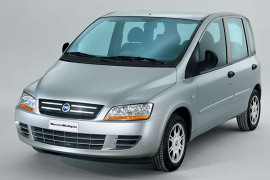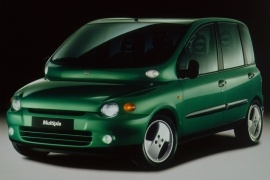FIAT Multipla Models/Series Timeline, Specifications & Photos
First production year: 1998
Engines: Gasoline, Diesel
Body style: Van
It’s no secret that the first model released in 1998 was not that well appreciated. I mean… it did win the Top Gear Car of the Year in 2000 due to its practicality, but still got the title of the “Ugliest Car” within the same programme.
For 2004, Fiat tried to rectify the exterior design and the model underwent a huge facelift.
Aesthetically, the all new Multipla featured new headlights, a reprofiled hood and a generally more streamlined look, turning it into a more anonymous and less controversial vehicle. The bulge where the hood and the cabin met was removed. The new Multipla was 2cm wider and 4cm longer, with a revised bumper.
The innovative three-by-two seating layout was kept, thus the small Multipla could accommodate up to 6 occupants.
Inside, the cabin’s design was not really updated, thus the dashboard was already looking a little dated. The quality of the materials used was not the best, but everything looked well put together.
The cabin was roomy and the trunk’s size was enormous for a car of this size.
At the wheel, the driver had a good driving position and enjoyed increased visibility, while the dash-mounted gearshift was within easy reach and worked smoothly.
The trim levels SX and ELX were replaced by the new Dynamic, Dynamic Plus and Eleganza. The base model was almost-well-equipped, featuring anti-lock brakes with electronic brake distribution, front airbags, electric windows and others, but still lacked air-conditioning.
Rarely in car's history, a vehicle received so much hate about its look than the 1998 Fiat Multipla. Its questionable look was only matched, or exceeded, by the Pontiac Aztek.
It is hard to describe a car that was built around a functional concept. While the engineers burned the midnight oil to tick all the boxes from the book, the design team looks like it drew the lines with their lunchboxes during the 1994 World Soccer Cup Final when Italy lost to Brazil. But the 4 meters (13.1 ft) long car could transport six adult passengers and 400 liters (14 cu-ft) of luggage, and that was its main advantage on the market.
The short front end featured a step design. One step for the bumper, one for the hood, another one for a bar with a pair of lamps, and a steep windshield formed the car's shape. The rest of the vehicle was a cube with rounded edges and a vertical drop for the tailgate. Its three sets of lights, for fog, main, and the stationary lamps were installed to end the vehicle's unusual look.
Inside, there was room for up to six people on individual seats. To accommodate them, Fiat moved the gear-stick from the floor to the center stack. It was integrated into a panel that combined the instrument cluster, the HVAC, and the sound system.
Fiat left enough room for almost any kind of engine from its warehouse under the hood, but it chose to offer just two of them: a diesel and a gasoline unit. Both were paired to a 5-speed manual gearbox.

